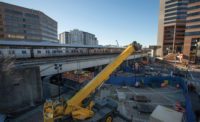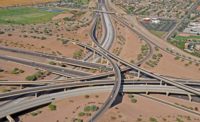Compared with most other freeways in metropolitan Phoenix, the 13-mile segment of Loop 101 between I-17 on the city’s north side and Pima Road in Scottsdale is relatively new, having been completed in the late 1990s. In that short span of time, however, the area’s population has grown by more than 60%, an increase that has put more vehicles on major roadways and accelerated demands on the highway’s design capacity, particularly during peak morning and evening travel periods.
A $185-million design-build widening project currently underway by the Arizona Dept. of Transportation aims to ease congestion woes in the corridor, also known as the Pima Freeway.
The joint venture of Coffman Specialties/Ames Construction and lead designer T.Y. Lin International is carrying out the addition of a 12-ft-wide travel lane in each direction, plus new auxiliary lanes along a particularly congested two-mile section. All shoulders along the corridor will be widened to a standard 12 ft as well.
Other improvements include modified ramp and frontage road connections at 11 interchanges and more than 326,000 sq ft of new and replacement sound and retaining walls to help insulate adjacent neighborhoods from traffic noise.
Alternative Delivery
While the use of design-build is a fairly common practice for ADOT, “this is one of the largest applications we’ve delivered,” says John Halvarson, the agency’s resident engineer.
By using design-build, he says the project team has greater control over the scope and schedule of construction. There’s also the advantage of having in-house technical analysis readily available for contractor-requested changes prior to ADOT’s approval.
“Not only were we able to bid different concepts that helped reduce costs before work got underway,” says T.Y. Lin project manager Joe Heller, “we have also been able to refine these innovations while keeping the project on schedule.”
“Communication is good between all stakeholders, with the project staff resolving issues as quickly as possible.”
– John Halvarson, Resident Engineer, ADOT
In the months leading up to the scheduled February 2019 start, the project team faced some unusual challenges, such as reconciling as-built drawings that had been developed using metric measurements and a different vertical datum from what ADOT now uses.
Another design-build team responsibility—utility coordination—was occasionally challenging as well. Coffman/Ames project manager Greg Brown notes that for a relatively new highway, the Pima Freeway corridor was rife with undocumented underground utilities.
“Most were cable and communication lines,” Brown says. “It wasn’t a huge issue, but we had to be ready to rearrange task schedules while waiting for them to be moved.”
As with most expansion efforts on already busy highways, the Pima Freeway improvements presented the project team with inherent issues of safety, schedule and minimizing traffic disruptions while efficiently placing the 12-in.-thick concrete base in the new lanes and performing associated shoulder work. To help reduce impacts of lane shifts and ramp alterations on motorists, Coffman/Ames essentially split the project corridor in half, with crews working concurrently from both ends toward the approximate midway point at the State Route 15 interchange.
One of the biggest benefits of the alternative delivery approach has been in developing strategies to widen the freeway’s 26 original bridges and overpasses, which have spans ranging from 100 ft to 200 ft. Rather than simply extend the structures’ original cast-in-place design, the project team used precast AASHTO Type 5 I-girders and bulb tees placed on drilled shafts from 60 ft to 100 ft deep. Heller says the simplified strategy requires less shoring and maintains the necessary clearances for cross traffic beneath the freeway. Buying forms from a local supplier also helped Coffman/Ames solidify the project’s supply chain amid high demand for precast materials in the Phoenix market.
An entirely new precast overpass is being constructed across the alignment for what will eventually be an extension of Miller Road, near the freeway’s east end in Scottsdale.
Shifting traffic to the outer lanes allows Coffman/Ames to excavate the inner area 25 ft from grade down to the future road elevation, then install the shoring, foundations, cast-in-place retaining walls and girders for the new structures. Traffic will be shifted onto the new bridge when it’s complete, and the process will be repeated for outer sections of the new crossing.
Widening the bridges at interchanges has the added complication of reworking vertical and horizontal elevations for exit and entrance ramps.
“While the original plan was to keep them open throughout construction, we worked with ADOT to implement short-term closures that have helped eliminate complexities from the rebuilding and repaving process,” Brown says.
Adaptive Alternative
The project team applied a different structural strategy for a cast-in-place, post-tensioned box-girder bridge spanning the Pima Freeway at 15th Avenue. With insufficient space to add new lanes within the existing abutments, the entire four-lane structure seemed destined for demolition and replacement. Instead, the project team crafted a reuse strategy that began with excavating around the existing abutment, building up a new pier wall from grade and installing drilled shafts and retaining walls for the new abutments.
With the bridge jacked a few inches off the old abutment structures, cantilever spans of 8.5 ft and 21 ft 2 in. were added on both ends to the new pier wall and offset with 20-ft to 25-ft backspans. Once the new abutment work was complete, the bridge was then gently lowered onto what Heller calls a “hinge” in the cantilevered span and post-tensioned, allowing the last of the old supports to be demolished.
Another cost-saving innovation was the use of toe-down barriers at several locations, which Brown says eliminated the need for approximately 1,700 ft of retaining walls. “They are also faster to install, allowing us to build up to 200 feet per day,” he says.
With construction currently on track for completion later this year, Halvarson says the construction phase has proceeded with relatively few problems despite the COVID-19 outbreak.
“Communication is good between all stakeholders, with the project staff resolving issues as quickly as possible,” he says. That includes a recent decision to use diamond-profile girding for the travel lane slabs instead of the original plan to apply rubberized asphalt pavement as a noise-reduction measure.
And while construction was already well underway before the pandemic, Brown says new safety and social-distancing protocols to minimize workers’ potential for exposure to the virus had little impact on the building process. He says initial concerns about shortages of light poles and other materials during construction have likewise not emerged.
The only issue that’s become somewhat problematic, Brown says, is moving construction personnel around the jobsite.
“You can’t just load eight people in a van anymore,” he says. “You have to plan these kinds of moves a little more carefully.”









